A Dios Baby Roosters
/On Mother's Day this year we had 7 baby chicks born to our rotating cast of three broody hens. (Certain mornings they almost seemed to be sitting on top of each other.)
Read MoreOn This Miraculous Planet, On Real Food, On Union with all that is
On Mother's Day this year we had 7 baby chicks born to our rotating cast of three broody hens. (Certain mornings they almost seemed to be sitting on top of each other.)
Read MoreI had been feeling wary of this upcoming event and my role as a chicken pimp, but we had no choice. Either we were going to kill the girls and bring them with us to our temporary rental home in the freezer, or we were going to give them to friends who have many chickens in their flock.
It seemed highly ridiculous that killing a living creature was deemed better than letting nature take its course – so our girls were introduced to their new flock. Five minutes later, two of our girls were ruffling their feathers, seemingly unperturbed by the 10-second coitus.
Saying goodbye to our chickens was the last in a long list of adieus as we leave this wonderful town.
We have lived here six years, and I feel I only know 40 percent of what makes Ann Arbor wonderful, especially in the realm of food.
As food is the only carnal thing humans can do in public, I salute all those who pursue this world. I am grateful to you all. This world of feeding our bodies, our health, our souls.
Here is the article on Annarbor.om
What I didn't write in this article was the sense of vertigo that accompanied the list upon list upon list as we sold our house and left. Leaving a town where one has lived for 6 years, leaving a town where one went through residency, through oncology office visits, and through falling in love (with the food world, with one's husband, with the reality of the miraculous).
Onward to the next adventure!
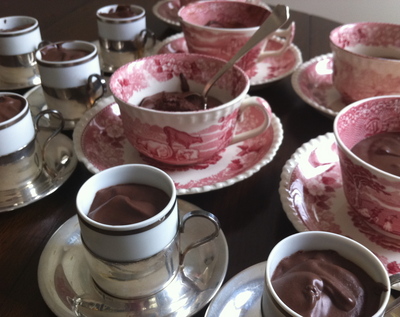
As always on the lookout for a recipe that will use a lot of eggs, I dug out my grandmother's chocolate mousse recipe. Ten eggs later, it is as decadent as I remember - an easy and delectable treat for you and your guests.
Unlike the plethora of chocolate mousse recipes: from Julia Child to my backyard egg mainstay book, "Eggs" by Michel Roux, this recipe does not call for any sort of dairy or butter. In fact, aside from the eggs, one could consider this vegan.
The recipe is easy and fast. The end result is scrumptious. Imagine eating a luxury dark chocolate bar with a spoon, like it is ice cream.
I procured my baking chocolate from Mindo Chocolates, our bean to bar business in Dexter. The 10 eggs were from our backyard chickens. Water, sugar and vanilla round out the ingredients.
Here is the recipe
1 pound best quality baking chocolate
½ cup granulated sugar
½ cup water
10 egg yolks
3 teaspoons vanilla
10 egg whites
Melt together (in a double boiler) the chocolate, sugar and water. Stir. When smooth, cool, stirring occasionally. Add well-beaten yolks and vanilla.
Beat egg whites until able to hold peaks. Fold egg whites into chocolate mixture. Put in a deep crock or individual serving dishes. Refrigerate at least 12 hours.
(Serves 6-8)
This is what I learned from doing the recipe.
Instead of using a double boiler to melt the chocolate, water and sugar - I used a metal bowl on top of a pot. That worked just as well and was much more economical than purchasing a double boiler. The chocolate is the consistency of icing when you add the egg yolks; there is no need to add extra water to make it creamy. I also learned that egg whites treble in volume when beaten, ending up on the floor. Next time I will use a larger bowl from the outset.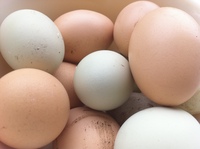
As for serving 6 to 8, I cannot imagine wanting to have more than ½ cup of this rich chocolate immersion after a full meal. I divided mine into 10 teacups and six espresso cups (making 16 servings) and refrigerated for 36 hours. I removed the cups from the refrigerator two hours before serving to bring out the flavors.
For those at your table who want something lighter and less intense, I would recommend offering at bowl of whipped cream and perhaps some berry jams. Everyone likes making his or her own dessert, and the chocolate mousse is sturdy enough to be the bass note of whatever dessert compilation is orchestrated.
Here is the article on annarbor.com
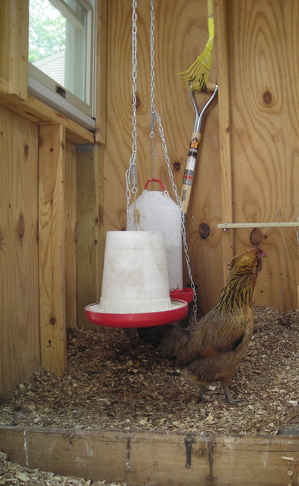
In one of my first chicken posts I mentioned the book I “borrowed†from my grandparents, Encyclopedia of Organic Gardening: A complete guide to gardening without DDT or other poisons or chemicals edited by J.I. Rodale (published in 1969). There is a section on poultry. I took their litter advice for our girls: “A practice that makes healthier and more productive chickens in deep litter, sometimes called built up litter. Simply let the little accumulate instead of cleaning out the poultry house every couple of weeks. Biological activity in the litter, just as in the compost heat, produces huge amounts of rich food.â€
Wait. Not cleaning out the litter from the coop on a weekly basis, me being lazy, is good for the girls? This seemed to good to be true! The section continues.
“Litter-reared chickens need no expensive animal proteins or mineral supplements, and if pastured or given ample feed in addition will need to vitamin A or D supplements. Antibiotics are also produced - litter-raised poultry is remarkably free from disease.â€
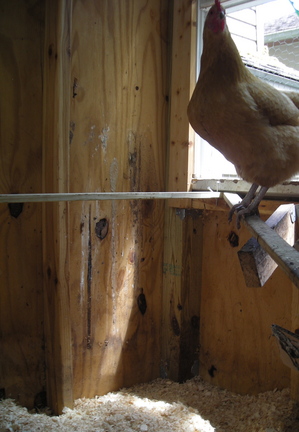
Wow. What a huge gift. It is healthier for the girls to live around microorganisms in their litter. And yet, summertime is for cleaning.
The Augean stables it was not, but there was about 10 inches of accumulated litter to be transferred onto the compost pile. Last August, we put pine chips 2 inches deep. Over the course of the year we added handfuls of pine chips and cedar chips. The cedar chips smell nice; yet we found cedar stains the outside of the egg, so it is better to avoid cedar where the girls are laying.
I don’t know if they care one way or another, but I love the fresh yellow and the smell of the new sawdust - should last about another week.
Here is the link to the article!
This appetizer combines two of my favorite things - farm fresh food and eggs from our girls!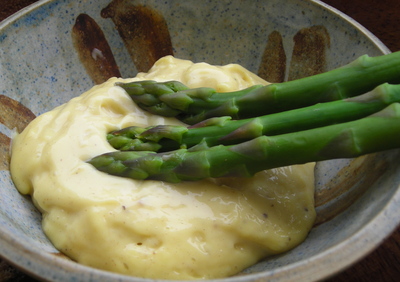 Asparagus dipped in homemade mayonnaise made from the eggs of our backyard chickens - I cannot think of a better way to celebrate the beginning of harvest bounty beginning to descend upon us.
Asparagus is wonderful for all sorts of reasons: it tastes amazing, when it leafs out the fronds are soft and silky like baby hair, and when you prepare it there is snapping involved. I did not realize until I was in college that not everyone snaps asparagus. I was taught to bend the cut stalk until it snaps - the area where it snaps will be the demarcation of where it is still chewable and where it will become stringy and difficult to eat.
Asparagus dipped in homemade mayonnaise made from the eggs of our backyard chickens - I cannot think of a better way to celebrate the beginning of harvest bounty beginning to descend upon us.
Asparagus is wonderful for all sorts of reasons: it tastes amazing, when it leafs out the fronds are soft and silky like baby hair, and when you prepare it there is snapping involved. I did not realize until I was in college that not everyone snaps asparagus. I was taught to bend the cut stalk until it snaps - the area where it snaps will be the demarcation of where it is still chewable and where it will become stringy and difficult to eat.
I was able to find glowing asparagus at Seedling's booth at the Westside Farmers Market. Seedling is located in South Haven, MI and they focus mainly on fruit. However, I had heard Locavorious was procuring asparagus from Seedling for their CSA and I was curious to try.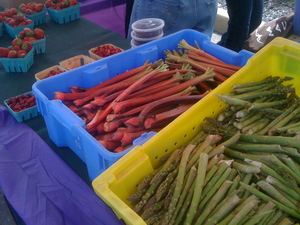
So I sat outside and snapped my way through a large handful - the leftover stalks to be divided equally between our chickens and to feed our vermiculture container inside the house (those worms are always hungry).
After snapping, I steamed the asparagus for 4 minutes and quickly ran them under cold water to stop them from continuing to cook.
Then I pulled out from the refrigerator our second attempt at making mayonnaise.
It seemed silly for us to be purchasing mayonnaise (one of my most favorite indulgences) when we have an abundant and never-ending supply of eggs. I was able to corner a family member to give me his recipe over Easter. His recipe is simple and elegant in its simplicity. 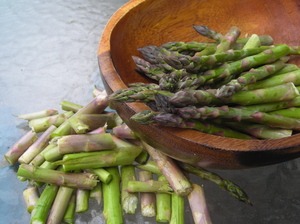
JP’s mayonnaise recipe: Two egg yolks, two cups of oil, juice of one full lemon, 2 tablespoons water, some white pepper, and a sprinkle of cayenne pepper to taste.
Blend together the two egg yolks and the lemon juice in a mason jar (I later learned this is important to prevent splatter). Still blending, slowly add the oil - the mixture should quickly solidify and lighten in color - if this does not happen, add another egg yolk. Continue to add the oil until it is all incorporated. Then add two tablespoons of water to stop the mixture from separating, or “oiling out.â€
Add pepper, and voila!
When we returned home we tried another recipe for mayonnaise that we found in our fancy book of egg recipes, Eggs, by Michel Roux. His recipe calls for Dijon mustard and white wine vinegar OR lemon juice, we went with the white wine vinegar.
Roux’s mayonnaise recipe: 2 egg yolks, 1 tbsp Dijon mustard, salt and freshly ground pepper, 1 cup peanut oil, 2 tbsp white wine vinegar/lemon juice.
Place into a bowl on a towel the egg yolks, mustard, salt, and pepper. Whisk. Slowly add a trickle of oil while you whisk. Once the mixture begins to thicken add the oil in a steady stream, whisking the whole time. Once the oil is incorporated, continue to whisk briskly for 30 seconds and then add the vinegar/lemon juice.
First of all, I used our manual blender and the mixture refused to thicken when I started adding the oil. Our hand-held electric blender worked much better and the mixture began to thicken - but the splattering was considerable (note the Mason jar in JP's recipe).
Taste wise, when I think of my ideal mayonnaise flavor, I prefer JP's recipe. The addition of mustard in the Roux's recipe adds an element of non-mayo that alters the essence of the mayonnaise flavor.
But the mustard-esque mayonnaise is a beautiful dunk for freshly cooked asparagus - it gives it a certain bite that offsets the grassy flavor of the green stalks.
Here is the article on annarbor.com.
The debate for the FDA about feeding chicken litter to cows appears to stem from their concern over Mad Cow disease, which strikes me as the tail wagging the dog. So before I talk about the dog, I will address the tail. Chicken litter, i.e. everything from the floor of a chicken house, sawdust, feathers, manure, spilled feed, etc., is being fed to cows in feedlots. The FDA temporarily banned the practice in 2003 because there was concern that the chicken feed (industrial chicken feed includes “recycled cattle proteins†and “ruminant meat and bone meal†- a.k.a. beef, in its ingredients) was spilling onto the litter and being fed back to the cows. As a chicken owner, I can verify that assumption - chickens are not neat eaters.
In February of 2003, a study done by the North American Rendering Industry, showed, “it will require feeding 10 pounds of poultry litter / cow / day for 6,442 days, or 17.65 years, to achieve a single ID50 dose!†The ID50 is the median infective dose for Mad Cow disease. Cows bred and fattened for industry live less than 2 years. The 17-year time frame is very compelling, and I can see why the FDA removed the chicken litter ban in their later rulings.
I had never heard of the National Renderers Association before reading their study, so I did some research.
Formed in 1933 as the professional association of the rendering industry, they process the leftover parts of the animals humans raise for meat and render the raw materials into usable products. As their Web site states: “Meat and bone meal, meat meal, poultry meal, hydrolyzed feather meal, blood meal, fish meal and animal fats are the primary products resulting from the rendering process. The most important and valuable use for these animal by-products is as feed ingredients for livestock, poultry, aquaculture, and companion animals.â€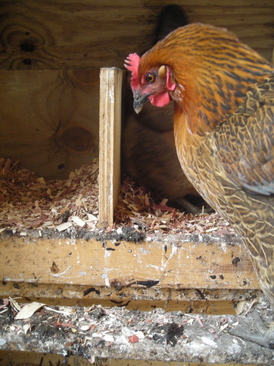
Nearly 59 billion pounds of animal byproducts are recycled and reused by the rendering association annually. One third to ½ of an animal we have bred for meat is not used and the renderers turn that into “feed ingredients†as well as “valuable ingredients for various soaps, paints and varnishes, cosmetics, explosives, toothpaste, pharmaceuticals, leather, textiles and lubricants.†Renderers are an integral part of the meat industry.
An association of renderers, who recycle leftover animal parts into animal food, paid for a study to show there is no harmful affect on cows eating cows (small amounts of cows). And honestly, who else has the time, inclination, or finances to run that study other than the people directly affected?
Assuming we have successfully rendered (hehe) the argument against chicken litter causing Mad Cow Disease null and void, let us return to the main point - feeding chicken litter to cows.
According to the North Carolina Extension service, the litter should be processed before being fed to cattle. There are several ways to process the litter, but the goal is to stack it to create conditions for bacteria to raise the temperature of the stack to 140 -160 degrees to kill pathogens present in raw litter (the main pathogen of concern being E. Coli).
The University of Missouri Extension has a chart discussing the nutrient basis of chicken litter. On average the litter contains 25 percent protein, which is a fairly cheap source of food for the beef farmer. The ability to recycle the huge amounts of waste from chicken factories into feed for beef in feedlots appears to be a win-win for all involved. Cheap feed for cows translates into cheap hamburgers.
Which brings us to consumer choice, and a theme I have touched on again and again - voting with your wallet. Do you want to eat cows that have ruminated litter from the floor of an industrial chicken facility, or do you want to eat animals that have masticated grass and felt the warm sun?
It is nice to have choices.
Here is the article on annarbor.com.
I love Eggs Benedict. I can’t pinpoint the beginning of my love affair, because my love has always been there. As Eggs Benedict features prominently in most menus, I don't think I am the only one in love.

For over 20 years, I resigned myself to eating Eggs Benedict in restaurants because I thought the sauce was too darn hard - the classic recipe for hollandaise sauce involves a double burner, a candy thermometer, and a metal bowl (none of which we own). But last Sunday, my partner, trusting as always in the infallibility of The Joy of Cooking and spurred on by my stated desire of what I wanted for Valentine’s Day brunch, kept reading, and persevered, finding a recipe for hollandaise that doesn’t require anything special but a blender.
And we own a blender, and we have fresh eggs that need to be eaten, and the entire delicious, plate-licking meal took us 6 minutes to make, and it was the easiest at-home most decadent brunch ever.
Here is our two-person recipe for Eggs Benedict, modified with more lemon juice to ensure a big sparkle of citrus to offset the fat. Four poached eggs, turkey bacon from freezer, leftover 8 grain 3 seed bread from Zingerman's, Hollandaise sauce made in the blender: 2 egg yolks, 2 teaspoons lemon juice, 1/3 cup melted ghee (clarified butter), salt and pepper - voila! (Note: This timeline assumes two sets of hands, and we like our eggs runny.)
T-minus 6 minutes: Check coop for fresh eggs, return with 4 fresh new eggs to add to the 2 on the windowsill from yesterday, turn heat on for poaching egg water, melt ghee, slice off 4 chunks of turkey bacon and throw into toaster oven with slices of bread.
T-minus 5 minutes: Separate 2 egg yolks into blender, add 2 teaspoons lemon juice, grind in pepper and salt, press toast on toaster oven.
T-minus 4 minutes: Take a sip of coffee, watch the bread turn into toast.
T minus 3 minutes: Set the table, scratch the dog.
T-minus 2 minutes: Break 4 eggs into the poaching egg water
A brief step-out from our countdown. I learned to make poached eggs years ago. The trick was to create little tornadoes in the water with a spoon and then gently pour the egg into the middle of the tornado. The force of the tornado made sure the egg didn’t spread all over the place. If the egg was being difficult, you could add some vinegar to the water. I always liked making water tornadoes with my spoon - so that is what I did.
Or, that was what I did until we started keeping chickens. I don’t need to make a tornado in the water any more. A freshly laid egg has a white that is almost as firm as the yolk. I am able to simply pour it into the warm water. They are so contained unto themselves, they can be literally on top of each other and still be intact when you spoon them out.
Okay, back to the countdown.
T-minus 90 seconds: Turn blender on and start foaming the yolk and lemon juice. After 10 seconds slowly pour in the melted ghee.
T-minus 30 seconds: (This takes some maneuvering to happen all at once). Remove toast and bacon from toaster, place the four pieces onto two plates, stack turkey bacon on top, remove the poached eggs from the water and place on top of bacon, use a spatula to pour the Hollandaise onto the eggs, carry plates to table.
Breakfast! Cut into the perfectly runny eggs, the salty, tangy bacon, the warm dense bread, and spread over it all the incredibly perfect Hollandaise sauce. Smile as your tongue dances with happiness.
Here is the link to the annarbor.com article!
One of my first memories of the holidays was navigating my grandparent’s home with my eyes fixed on a cup of egg nog clutched in my hands to bring to my parents. When I realized our girls would start laying around the holiday, making eggnog seemed a fine tribute to their efforts, especially after hearing a story about Salmonella being unable to survive in homemade spiked eggnog. Our girls started laying on December 26th, supported with lights, our best wishes, and laying mash (which has nutrients for strong shells).
We augmented our collection with eggs from Dragonwood Farm and plunged into making the recipe of family lore. Handed down on index cards to email, from my grandmother to my father to me.
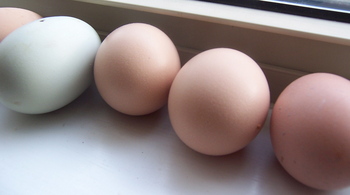
Dozen eggs, separated
Cup and a half of sugar
Beat yolks and sugar and put in huge bowl
Add a pint of amber rum and two cups of cheap brandy
Let sit
Add quart of milk
Beat quart of whipping cream
Beat egg whites
Add in and let sit
Add nutmeg
Serves 20-24
This remarkably simple recipe resulted in a great amount of nog. After folding in the egg whites and the whipped cream, the color was a soft inviting light yellow (thanks to the bright orange of the yolks, rum, and brandy). The texture felt to me like the almost melted bits at the end of a milk shake. The taste was wonderful, light, not overly alcoholic, a nice balance between kick and cream. I added cinnamon along with nutmeg and the aroma of the rum, brandy, and spices brought me back immediately to those holiday parties 20 years ago.
I like the idea of the term egg nog being a contraction of Egg ‘N Grog from the English term for Rum.
I also like the idea of expanding my repertory of egg recipes as the girls hit their stride. I feel I need to be worthy of their beautiful eggs.
Here is the article on annarbor.com.

My life vision is to love, be curious, identify my Cranky Monster, and be brave enough to speak from and for The Good.
Click here for more about me.
Powered by Squarespace.